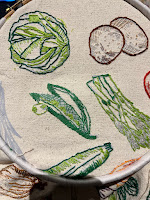On the cover of Inspirations 123 , Floe, the Fairy Penguin captured me immediately. I loved the concept, the embroidery, and the felt medium. I also have a friend who loves penguins. I bought the kit. Once my major knitting projects were completed I decided to treat myself to making it.
Cutting out was fairly straightforward. The instructions for transferring the design seemed to me unnecessarily complicated, so I copied the pattern markings by hand, using lead pencil on the white and chalk pencil on the black. I had, of course, to either work fast or keep renewing the pencil marks on felt, but a combination of both worked well.
There is a variety of threads, including several different wools and silks. Getting the right one for each stitch kept me focused. (Would it matter? Not sure.)
The trickiest part was getting the curves right while stitching it together.
Without a beak and flippers it took on a slightly sinister look which I could only pray would disappear when finished.

The stuffing, however, had to come first. I decided against the recommended filling of either rice or oven-hardened beans. I figured the chance of a doorstop getting wet was too high, so bought a bag of stones from Bunnings. These went neatly into the base in the kit-included cotton bag. Filling the upper body to make it firm took a significant amount of wool fibre stuffing, but worked the required magic on the shape as I stitched over the back join (not in the recommended colour!)
I am delighted with the result.
As I had hoped, the beak and flippers turned it immediately into a recognisable penguin.
Floe emerged in all her splendour, with plenty of personality and anxious to get to her real home.
She didn't fit into any of the standard Australia Post boxes, but I had one that had already travelled the world and packed her in using bits of bubblewrap, shredding, tissue and paper bags. She travelled overnight and reached her new home this morning.
She is already at home and welcome. My friend refuses to put her on the floor and she has found her new niche at eye level.
I really enjoyed the challenge, both stitching and construction. It isn't a project I would recommend to an embroidery beginner, unless in a class or group with help, but with a bit of experience it is a really satisfying project.
I'm glad I went with the Floe.

 The pencils are fixed on fabric by wetting. I used water to wet the pencils as I drew. The colour gradually spreads. I like it better before it spread, but no matter.
The pencils are fixed on fabric by wetting. I used water to wet the pencils as I drew. The colour gradually spreads. I like it better before it spread, but no matter. To make sure it was set, I ironed, washed, rinsed it in vinegar, hung it out to dry, then ironed it again. It's a pretty messy spread, but I think this is how the pencils are intended to work.
To make sure it was set, I ironed, washed, rinsed it in vinegar, hung it out to dry, then ironed it again. It's a pretty messy spread, but I think this is how the pencils are intended to work.















































